-

新人教版高中英语选修2Unit 1 Science and Scientists-Learning about Language教学设计
Step 7: complete the discourse according to the grammar rules.Cholera used to be one of the most 1.__________ (fear) diseases in the world. In the early 19th century, _2_________ an outbreak of cholera hit Europe, millions of people died. But neither its cause, 3__________ its cure was understood. A British doctor, John Snow, wanted to solve the problem and he knew that cholera would not be controlled _4_________ its cause was found. In general, there were two contradictory theories 5 __________ explained how cholera spread. The first suggested that bad air caused the disease. The second was that cholera was caused by an _6_________(infect) from germs in food or water. John Snow thought that the second theory was correct but he needed proof. So when another outbreak of cholera hit London in 1854, he began to investigate. Later, with all the evidence he _7_________ (gather), John Snow was able to announce that the pump water carried cholera germs. Therefore, he had the handle of the pump _8_________ (remove) so that it couldn't be used. Through his intervention,the disease was stopped in its tracks. What is more, John Snow found that some companies sold water from the River Thames that __9__________________ (pollute) by raw waste. The people who drank this water were much more likely _10_________ (get) cholera than those who drank pure or boiled water. Through John Snow's efforts, the _11_________ (threaten) of cholera around the world saw a substantial increase. Keys: 1.feared 2.when 3. nor 4.unless 5.that/which 6.infection 7.had gathered 8.removed 9.was polluted 10.to get 11. threat

新人教版高中英语选修2Unit 1 Science and Scientists-Reading and thinking教学设计
Step 5: After learning the text, discuss with your peers about the following questions:1.John Snow believed Idea 2 was right. How did he finally prove it?2. Do you think John Snow would have solved this problem without the map?3. Cholera is a 19th century disease. What disease do you think is similar to cholera today?SARS and Covid-19 because they are both deadly and fatally infectious, have an unknown cause and need serious public health care to solve them urgently.keys:1. John Snow finally proved his idea because he found an outbreak that was clearly related to cholera, collected information and was able to tie cases outside the area to the polluted water.2. No. The map helped John Snow organize his ideas. He was able to identify those households that had had many deaths and check their water-drinking habits. He identified those houses that had had no deaths and surveyed their drinking habits. The evidence clearly pointed to the polluted water being the cause.3. SARS and Covid-19 because they are both deadly and fatally infectious, have an unknown cause and need serious public health care to solve them urgently.Step 6: Consolidate what you have learned by filling in the blanks:John Snow was a well-known _1___ in London in the _2__ century. He wanted to find the _3_____ of cholera in order to help people ___4_____ it. In 1854 when a cholera __5__ London, he began to gather information. He ___6__ on a map ___7___ all the dead people had lived and he found that many people who had ___8____ (drink) the dirty water from the __9____ died. So he decided that the polluted water ___10____ cholera. He suggested that the ___11__ of all water supplies should be _12______ and new methods of dealing with ____13___ water be found. Finally, “King Cholera” was __14_____.Keys: 1. doctor 2. 19th 3.cause 4.infected with 5.hit 6.marked 7.where 8.drunk 9.pump 10.carried 11.source 12.examined 13.polluted 14.defeatedHomework: Retell the text after class and preview its language points

新人教版高中英语选修2Unit 1 Science and Scientists-Using langauge教学设计
This happens because the dish soap molecules have a strong negative charge, and the milk molecules have a strong positive charge. Like magnets, these molecules are attracted to each other, and so they appear to move around on the plate, taking the food coloring with them, making it look like the colors are quickly moving to escape from the soap.Listening text:? Judy: Oh, I'm so sorry that you were ill and couldn't come with us on our field trip. How are you feeling now? Better?? Bill: Much better, thanks. But how was it?? Judy: Wonderful! I especially liked an area of the museum called Light Games.it was really cool. They had a hall of mirrors where I could see myself reflected thousands of times!? Bill: A hall of mirrors can be a lot of fun. What else did they have?? Judy: Well, they had an experiment where we looked at a blue screen for a while, and then suddenly we could see tiny bright lights moving around on it. You'll never guess what those bright lights were!? Bill: Come on, tell me!? Judy: They were our own blood cells. For some reason, our eyes play tricks on us when we look at a blue screen, and we can see our own blood cells moving around like little lights! But there was another thing I liked better. I stood in front of a white light, and it cast different shadows of me in every color of the rainbow!? Bill: Oh, I wish I had been there. Tell me more!? Judy: Well, they had another area for sound. They had a giant piano keyboard that you could use your feet to play. But then, instead of playing the sounds of a piano, it played the voices of classical singers! Then they had a giant dish, and when you spoke into it, it reflected the sound back and made it louder. You could use it to speak in a whisper to someone 17 meters away.? Bill: It all sounds so cool. I wish I could have gone with you? Judy: I know, but we can go together this weekend. I'd love to go there again!? Bill: That sounds like a great idea!

新人教版高中英语选修2Unit 2 Bridging Cultures-Discovering useful structures教学设计
The grammar of this unit is designed to review noun clauses. Sentences that use nouns in a sentence are called noun clauses. Nominal clauses can act as subject, object, predicate, appositive and other components in compound sentences. According to the above-mentioned different grammatical functions, nominal clauses are divided into subject clause, object clause, predicate clause and appositive clause. In this unit, we will review the three kinds of nominal clauses. Appositive clauses are not required to be mastered in the optional compulsory stage, so they are not involved.1. Guide the students to judge the compound sentences and determine the composition of the clauses in the sentence.2. Instruct students to try to learn grammar by generalizing grammar rules, controlling written practice, and semi-open oral output.3. Inspire the students to systematize the function and usage of noun clause1.Instruct students to try to learn grammar by generalizing grammar rules, controlling written practice, and semi-open oral output.2.Inspire the students to systematize the function and usage of noun clauseStep1: The teacher ask studetns to find out more nominal clauses from the reading passage and udnerline the nominal clauses.

新人教版高中英语选修2Unit 3 Food and Culture-Discovering useful structures教学设计
The newspaper reported more than 100 people had been killed in the thunderstorm.报纸报道说有一百多人在暴风雨中丧生。(2)before、when、by the time、until、after、once等引导的时间状语从句的谓语是一般过去时,以及by、before后面接过去的时间时,主句动作发生在从句的动作或过去的时间之前且表示被动时,要用过去完成时的被动语态。By the time my brother was 10, he had been sent to Italy.我弟弟10岁前就已经被送到意大利了。Tons of rice had been produced by the end of last month. 到上月底已生产了好几吨大米。(3) It was the first/second/last ... time that ...句中that引导的定语从句中,主语与谓语构成被动关系时,要用过去完成时的被动语态。It was the first time that I had seen the night fact to face in one and a half years. 这是我一年半以来第一次亲眼目睹夜晚的景色。(4)在虚拟语气中,条件句表示与过去事实相反,且主语与谓语构成被动关系时,要用过去完成时的被动语态。If I had been instructed by him earlier, I would have finished the task.如果我早一点得到他的指示,我早就完成这项任务了。If I had hurried, I wouldn't have missed the train.如果我快点的话,我就不会误了火车。If you had been at the party, you would have met him. 如果你去了晚会,你就会见到他的。

新人教版高中英语选修2Unit 3 Food and Culture-Reading and thinking教学设计
The discourse explores the link between food and culture from a foreign’s perspective and it records some authentic Chinese food and illustrates the cultural meaning, gerography features and historic tradition that the food reflects. It is aimed to lead students to understand and think about the connection between food and culture. While teaching, the teacher should instruct students to find out the writing order and the writer’s experieces and feelings towards Chinese food and culture.1.Guide the students to read the text, sort out the information and dig out the topic.2.Understand the cultural connotation, regional characteristics and historical tradition of Chinese cuisine3.Understand and explore the relationship between food and people's personality4.Guide the students to use the cohesive words in the text5.Lead students to accurately grasp the real meaning of the information and improve the overall understanding ability by understanding the implied meaning behind the text.1. Enable the Ss to understand the structure and the writing style of the passage well.2. Lead the Ss to understand and think further about the connection between food and geography and local character traits.Step1: Prediction before reading. Before you read, look at the title, and the picture. What do you think this article is about?keys:It is about various culture and cuisine about a place or some countries.

新人教版高中英语选修2Unit 5 First Aid-Discovering useful structures教学设计
You have no excuse for not going.你没有理由不去。He was punished for not having finished his homework.他因未完成作业而受到惩罚。2.动词ing形式复合结构由物主代词或人称代词宾格、名词所有格或普通格加动词ing,即“sb./sb.'s+doing”构成。动词ing形式的复合结构实际上是给动词ing形式加了一个逻辑主语。动词ing形式的复合结构有四种形式:①形容词性物主代词+动词ing②名词所有格+动词ing③代词宾格+动词ing④名词+动词ingHer coming to help encouraged all of us.她来帮忙鼓舞了我们所有人。The baby was made awake by the door suddenly shutting.这个婴儿被突然的关门声吵醒了。Can you imagine him/Jack cooking at home?你能想象他/杰克在家做饭的样子吗?无生命名词无论是作主语还是作宾语都不能用第②种形式。Tom's winning first prize last year impressed me a lot.汤姆去年得了一等奖使我印象深刻。Do you mind my/me/Jack's/Jack leaving now?你介意我/杰克现在离开吗?Excuse me for my not coming on time.很抱歉我没能按时来。His father's being ill made him worried.他父亲病了,他很担心。We are looking forward to the singer's/the singer to give us a concert.我们盼望着这位歌手来给我们举办一场演唱会。

高中数学对数函数教师说课稿
一、 教学目标根据教学大纲的要求以及本节课的地位与作用,结合高一学生的认知特点确定教学目标如下:学习目标:1、复习巩固对数函数的图像及性质2、运用对数函数的性质比较两个数的大小能力目标:1、 培养学生运用图形解决问题的意识即数形结合能力2、学生运用已学知识,已有经验解决新问题的能力3、 探索出方法,有条理阐述自己观点的能力
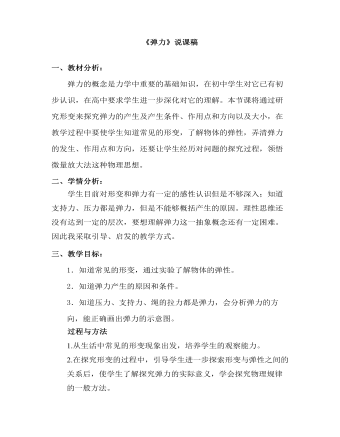
高中物理人教版必修一《弹力》说课稿
二、学情分析:学生目前对形变和弹力有一定的感性认识但是不够深入;知道支持力、压力都是弹力,但是不能够概括产生的原因。理性思维还没有达到一定的层次,要想理解弹力这一抽象概念还有一定困难。因此我采取引导、启发的教学方式。
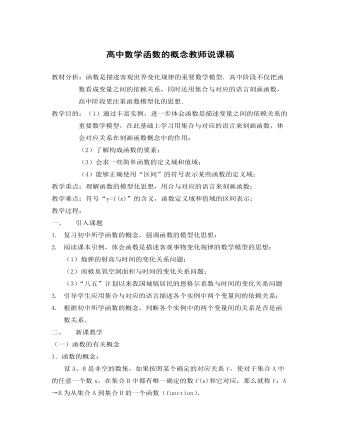
高中数学函数的概念教师说课稿
一、 引入课题1. 复习初中所学函数的概念,强调函数的模型化思想;2. 阅读课本引例,体会函数是描述客观事物变化规律的数学模型的思想:(1)炮弹的射高与时间的变化关系问题;(2)南极臭氧空洞面积与时间的变化关系问题;(3)“八五”计划以来我国城镇居民的恩格尔系数与时间的变化关系问题3. 引导学生应用集合与对应的语言描述各个实例中两个变量间的依赖关系;4. 根据初中所学函数的概念,判断各个实例中的两个变量间的关系是否是函数关系.
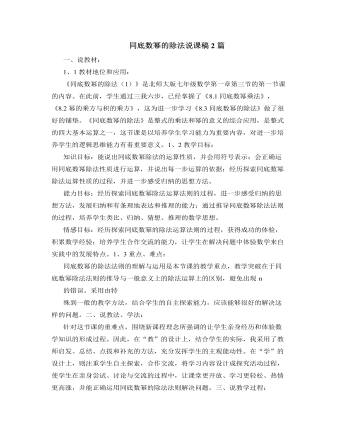
北师大版初中七年级数学下册同底数幂的除法说课稿2篇
设计意图:知识的掌握需要由浅到深,由易到难.我所设计的三个例题难度依次上升,根据由简到难的原则,先让学生学会熟悉选用公式,再进一步到公式的变形应用,巩固知识.特别是第三题特别强调了运用法则的前提:必需要底数相同.为加深学生对法则的理解记忆,形成“学以致用”的思想.同时为了调动学生思考,接下来让学生进入反馈练习阶段,进一步巩固记忆.4、知识反馈,提高反思练习1(1)口答设计意图:根据夸美纽斯的教学巩固性原则,为了培养学生独立解决问题的能力,在例题讲解后,通过让个别同学上黑板演演,其余同学在草稿本上完成练习的方式来掌握学生的学习情况,从而对讲解内容作适当的补充提醒.同时,在活动中引起学生的好奇心和强烈的求知欲,在获得经验和策略的同时,获得良好的情感体验.
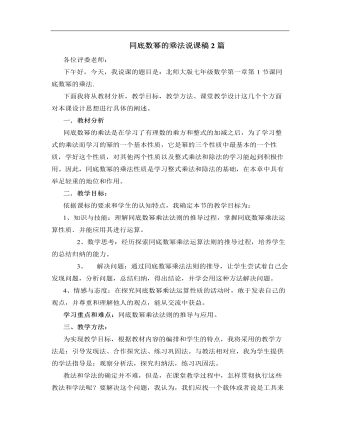
北师大版初中七年级数学下册同底数幂的乘法说课稿2篇
4、巩固新知,拓展新知(羊羊竞技场)本环节在学生对性质基本熟悉后安排了四组训练题,为避免学生应用性质的粗糙感,以小羊展开竞技表演为背景,让学生在轻松愉快的氛围中层层递进,不断深入,达到强化性质,拓展性质的目的。提高学生的辨别力;进一步增强学生运用性质解决问题的能力;训练学生的逆向思维能力,增强学生应变能力和解题灵活性.5、提炼小结完善结构(羊羊总结会)“通过本节课的学习,你在知识上有哪些收获,你学到了哪些方法?”引导学生自主总结。设计意图:使学生对本节课所学知识的结构有一个清晰的认识,能抓住重点进行课后复习。以及通过对学习过程的反思,掌握学习与研究的方法,学会学习,学会思考。6、课堂检测,发展潜能(大战灰太狼)
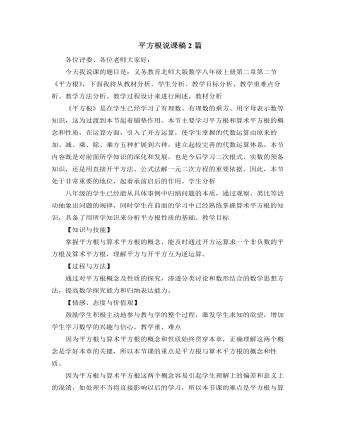
北师大版初中八年级数学上册平方根说课稿2篇
让学生先独立解决⑴题,再小组交流⑵题的答案,找到解题的方法.2、例2,例3是对平方根概念的巩固与拓展,在例2中由于学生还不熟于平方根的表示方法,所以应在平方根的概念和±号上加以明确,而例3则要把握平方根概念的本质,根据该数的正负或0来确定其平方根,这部分内容可用板演或展台展示结果的方式进行,让学生独立完成,应给予恰当的评价.3、最后,我又设计了一道辨析题:在做一道求4的平方根的题目时,小明说:“4的平方根是2”,小红说:“4的平方根是-2”,小强说:“2是4的平方根”小芳说:“-2是4的平方根”,请问他们的说法正确吗?通过这道题目,使学生在熟悉平方根概念的基础上更加深理解,同时对以往五种运算中从未出现过的一题两解的现象作出了解释,使学生明白了一种整体与局部的关系,再一次突出了重点.
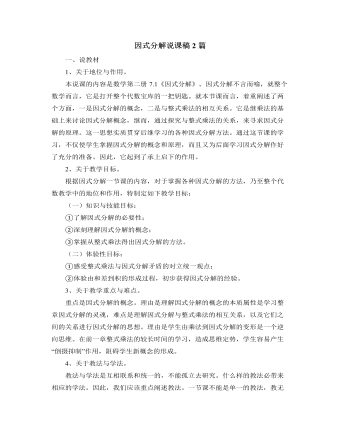
北师大版初中数学八年级下册因式分解说课稿2篇
情景感知概括运用设疑诱导动手操作合作交流尝试活动启发引导类比发现演练结合观察分析自主探索问题讨论利用尝试活动“我来当老师!”给学生提供设计问题的机会,培养他们实事求是的科学态度,勇于质疑、敢于创新的良好习惯及数学应用能力。例1、根据因式分解的概念,判断下列由左边到右边的变形,哪些是因式分解,哪些不是,为什么?通过罗列一些似是而非、容易产生错误的对象让学生辨析,促使他们认识概念的本质、确定概念的外延,从而形成良好的认知结构。例2:解答下列问题:(1)993-99能被99整除吗?能被98整除吗?能被100整除吗?(2)求代数式IR1+IR2+IR3的值,其中R1=19.2,R2=35.4,R3=32.4,I=2.5。让学生进一步体会用分解因式解决相关问题的简捷性。例3、填空:若x2+mx-n能分解成(x-2)(x-5),则m=,n=。

北师大版初中八年级数学上册三角形内角和定理说课稿2篇
三、说教法和学法:1、说教法:本节课采用几何画板与电子白板相结合的教学手段,使操作过程形象、直观呈现,以便学生更好的理解。在教学过程中,引导学生去探索,使学生感受到添加辅助线的数学思想,更好地掌握三角形内角和定理的证明及简单的应用,2、说学法:根据本节课特点和学生的实际,在教学过程中给学生足够的时间认真、仔细地动手书写证明过程,使学生的学习落到实处。同时,培养学生科学的学习方法和自信心。四、说教学过程设计教学过程的设计有:1、问题引入新课:七年级已经学习三角形内角和定理内容。这样从已经学过的知识引入,符合学生的认知规律。在拼图活动中发展思维的灵活性、创造性,为下一环节“说理”证明作好准备,使学生体会到数学来源于实践,同时对新知识的学习有了期待。
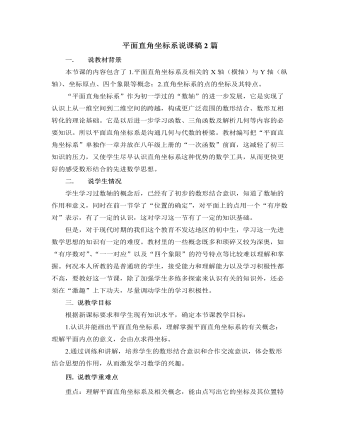
北师大版初中八年级数学上册平面直角坐标系说课稿2篇
【设计意图】:这一环节的设计主要是为了培养学生自主学习的能力,让学生在自学中初步认识概念。通过材料的阅读,活动的实践,让学生在自画、自纠中,加深对概念的理解,培养学生良好的画图习惯。(三)例题讲解学生活动4:(由于例题都比较简单,所以让学生自己先做,教师巡视指导)例1、写出图中A、B、C、D、E各点的坐标。例2、在直角坐标系中,描出下列各点:A(4,3), B(-2,3),C(-4,-1),D(2,-2)。【设计意图】:例1的目的是给出点的位置,写出点的坐标。例2的目的是给出点的坐标,描出点。学完概念之后,马上对概念进行应用,达到巩固的目的。当时上课时这2道例题的解答都比较圆满,绝大部分学生都能顺利做出。
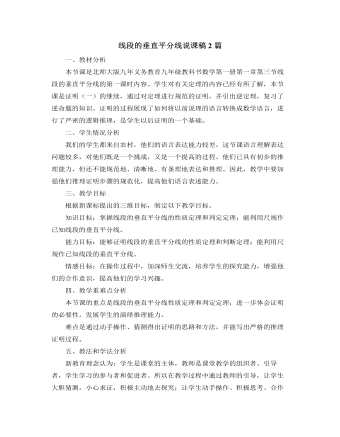
北师大版初中数学八年级下册线段的垂直平分线说课稿2篇
活动四:自主学习,尺规作图先阅读,再尝试作图,思考作图道理,小组讨论,“为什么作图过程中必须以大于1/2AB的长为半径画弧?”同桌演示尺规作图。最后折纸验证,使整个学习过程更加严谨。我将用下面这个课件给学生展示作图过程。再次回顾情境,让学生完成情境中的问题。(三)讲练结合,巩固新知第一个题目是直接运用性质解决问题,比较简单,面向全体学生。我还设计了第二个题目,想训练学生审题的能力。(四)课堂小结在学生们共同归纳总结本节课的过程中,让学生获得数学思考上的提高和感受成功的喜悦并进一步系统地完善本节课的知识。(五)当堂检测为了检测学生学习情况,我设计了当堂检测。第一个题目,让学生学会转化的思想来解决问题;第二个题目练习尺规作图。
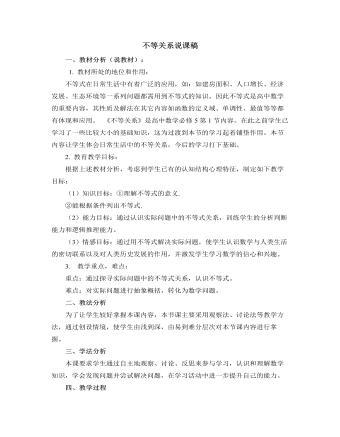
北师大版初中数学八年级下册不等式的基本性质说课稿
[设计意图]节环节的设置是为了使学生在掌握不等式性质的基础之上,加以拓展的作业,使课程的内容不但能满足全体学生需求,更能满足学有余力的学生得到更大收获,从数轴上获取信息来完成填空,从而体现数形结合的思想,学生通过参与活动,体会挑战成功的喜悦,并且他们的求胜心理得到了满足,沉醉在知识给他们带来的快感中完成本节课的学习,(六)课堂小结最后,凯旋归来话收获:通过本节课的学习,你收获到了什么?学生们都积极的举手回答,说出了各种各样的收获,比如:1、学会了不等式的三条基本性质2、学会了用字母来表示不等式的性质3、学生不等式与等式的区别等等;学生在回答的时候,老师加以评价和表扬并展示主要内容;这里教师要再次强调,特别注意性质3,两边同乘(或除以)一个负数时,不等号的方向要改变,数学思想的方法是数学的灵魂,这节课我们体验了三种数学思想,一是类比的思想,二是数形结合的思想,三是分类讨论的思想,
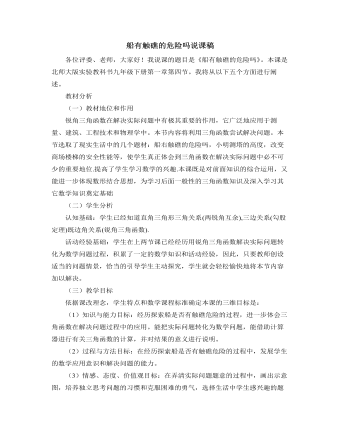
北师大版初中数学九年级下册船有触礁的危险吗说课稿
5、板书设计 §1.4船有触礁的危险吗 一、船布触礁的危险吗 1.根据题意,画出示意图.将实际问题转化为数学问题. 2.用三角函数和方程的思想解决关于直角三角形的问题. 3.解释最后的结果. 二、测量塔高 三、改造楼梯 五布置课后作业: 习题1.6第12 3题 六、设计说明 具有现实意义和挑战性的内容的设计,激发学生的学习兴趣,使学生乐学。 开放性实践问题和分层作业的设置,满足每个学生的学习需求,使学生愿学。 多样的学习方式和适时引导,提高学生的学习质量,使学生能学。 背景多样,层层递进,适时反思,发展学生的数学思维能力,使学生活学。 当学生乐学、愿学、能学、活学时,就将学会学习,将学习当成乐趣,作为生命中不可或缺的部分,也为学生终生学习奠定良好的基础。
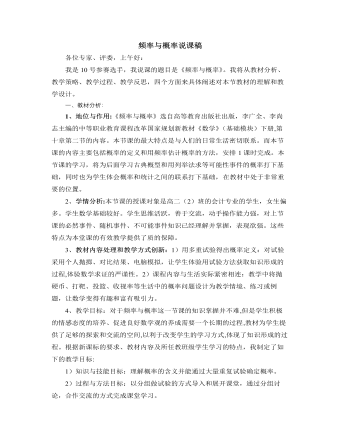
北师大版初中数学九年级下册频率与概率说课稿
一、教材分析:1、地位与作用:《频率与概率》选自高等教育出版社出版,李广全、李尚志主编的中等职业教育课程改革国家规划新教材《数学》(基础模块)下册,第十章第二节的内容。本节课的最大特点是与人们的日常生活密切联系。而本节课的内容主要包括概率的定义和用频率估计概率的方法,安排1课时完成。本节课的学习,将为后面学习古典概型和用列举法求等可能性事件的概率打下基础,同时也为学生体会概率和统计之间的联系打下基础,在教材中处于非常重要的位置。2、学情分析:本节课的授课对象是高二(2)班的会计专业的学生,女生偏多。学生数学基础较好。学生思维活跃,善于交流,动手操作能力强,对上节课的必然事件、随机事件、不可能事件知识已经理解并掌握,表现欲强。这些特点为本堂课的有效教学提供了质的保障。

